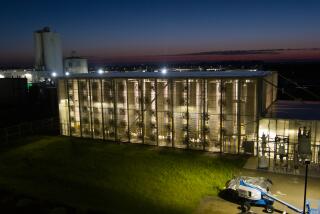Stanford calls in tech firepower for solar Start.Home
Itās ironic that the 2013 Solar Decathlon is taking place in a land of glassy office parks, big box stores and sprawling housing developments that too rarely use solar -- or other strategies of sustainable design. But that hasnāt stopped the teams here from incorporating technologies that are ahead of their time.
The Bruce Jenner of this decathlon arguably is Stanford, a school that wouldnāt surprise anyone with its engineering prowess. And even if you like to root against a favorite -- one that is competing in the Solar Decathlon for the first time and yet exhibiting just the slightest air of cockiness -- youād have to admit this team has delivered with its Start.Home.
Stanfordās strategy, said team member Derek Ouyang, a masterās student in structural engineering, was to harness Silicon Valleyās technological firepower to develop a feature-rich prototype that actually can sell in the marketplace.
PHOTOS: Stanford University Start.Home artist renderings
The team modeled its home on the mass-produced automobile, developing a centralized ācoreā mechanical room that controls plumbing, air distribution and electrical systems. It also contains the kitchen and bathroom. The remainder of the homeās modules can be customized and expanded around it, like a carās chassis around its engine. The coreās standardization and consolidation helps to simplify construction and bring costs down, the team said, as does the use of wood framing and lightweight structural insulated panels, or SIPS.
The homeās energy management system is hooked up to every circuit in the house. Via mobile app, it can control lighting, temperature, window shades, ceiling fans and other home functions. It also displays energy and water usage and can reveal the homeās biggest energy hogs. Even the homeās art (digital as well) uses data to represent energy usage abstractly.
āWe want to make sustainable people, not just a sustainable home,ā Ouyang said, describing his teamās vision of a house as educator. āItās more about encouraging the homeowner to take action.ā
Many of the homeās green technologies probably will be seen in homes near you--in 10 years. Glowing light switches, developed by students at Stanfordās product design program, are like programmable track pads. Depending on the custom settings, one finger can turn them off, two fingers can dim, four fingers can shut off everything, and so on.
FULL COVERAGE: Solar Decathlon 2013 main page
The homeās exterior EcoClean metal siding converts smog to nitric acid, which can easily be washed away. Wax-like phase change material wedged between aluminum ceiling panels softens in the heat of the day and hardens at night, keeping the temperature constant through thermal mass. Solar thin film, which elegantly resembles a sheet of glass, requires less energy to make and is less expensive than most other solar panels.
To give the home a Northern California look, the team employed reclaimed redwood flooring, decking and siding. Team members also wanted the main living space to feel more open, so they gave the room a 16-foot ceiling with clerestory windows and made the space 45 feet long. After the competition, the structure will make its final home at the Jasper Ridge Biological Preserve on campus, where Stanfordās resident ranger will live.
ALSO:
Early check on SCI-Arc/Caltech solar house
Middlebury College, biggest Solar Decathlon underdog?
Solar Decathlon 2013 preview: Looking ahead to the Great Park
JOIN THE CONVERSATION:
@latimeshome | pinterest.com/latimeshome | facebook.com/latimeshome | facebook.com/latimesgarden
More to Read
Inside the business of entertainment
The Wide Shot brings you news, analysis and insights on everything from streaming wars to production ā and what it all means for the future.
You may occasionally receive promotional content from the Los Angeles Times.









